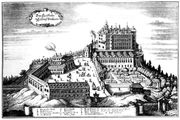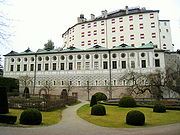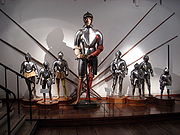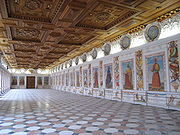
Ambras Castle
Encyclopedia

Schloss
Schloss is a German word for a building similar to a château, palace or manor house; or what in the British Isles would be known as a stately home...
in Innsbruck
Innsbruck
- Main sights :- Buildings :*Golden Roof*Kaiserliche Hofburg *Hofkirche with the cenotaph of Maximilian I, Holy Roman Emperor*Altes Landhaus...
, Austria
Austria
Austria , officially the Republic of Austria , is a landlocked country of roughly 8.4 million people in Central Europe. It is bordered by the Czech Republic and Germany to the north, Slovakia and Hungary to the east, Slovenia and Italy to the south, and Switzerland and Liechtenstein to the...
. Situated in the hills above Innsbruck, the Castle of Ambras is one of the most important sights of the city. Its cultural and historical importance is closely connected with Archduke Ferdinand II
Ferdinand II, Archduke of Austria
Ferdinand II, Archduke of Further Austria was ruler of Further Austria including Tirol.-Life account:...
and was a residence of his from 1563 to 1595.
In the lower part of the castle there are two rooms containing arms and armor, on the first floor a valuable art collection and in the upper part of the castle, the bathroom of Ferdinand's wife Philippine Welser
Philippine Welser
Philippine Welser was the morganatic wife of Ferdinand II, Archduke of Austria. Her family, the Welsers of Augsburg, were merchants and financiers of European significance and great wealth.-Works:* De re coquinaria , handwriting ca. 1545, Castle Ambras near Innsbruck. Inv.No...
. The Spanish hall between the lower and upper part of the castles is a notable example of German Renaissance architecture and is adorned with frescoes on the walls.
History
A fort existed on the site of the modern-day castle as early as the 10th century and was the seat of the House of AndechsCounts of Andechs
The House of Andechs was a feudal line of German princes in 12th and 13th century. The Counts of Dießen-Andechs obtained territiories in northern Dalmatia on the Adriatic seacoast, where they became Margraves of Istria and ultimately Dukes of a short-lived Imperial State named Merania from 1180 to...
. This fort was destroyed in 1133 and no traces of it remain, although some of the material from the original fort was used in the modern building.
The modern Ambras was built by Archduke Ferdinand II
Ferdinand II, Archduke of Austria
Ferdinand II, Archduke of Further Austria was ruler of Further Austria including Tirol.-Life account:...
, the second son of Emperor Ferdinand I
Ferdinand I, Holy Roman Emperor
Ferdinand I was Holy Roman Emperor from 1558 and king of Bohemia and Hungary from 1526 until his death. Before his accession, he ruled the Austrian hereditary lands of the Habsburgs in the name of his elder brother, Charles V, Holy Roman Emperor.The key events during his reign were the contest...
. When he was made the provincial sovereign of Tyrol
Tyrol (state)
Tyrol is a state or Bundesland, located in the west of Austria. It comprises the Austrian part of the historical region of Tyrol.The state is split into two parts–called North Tyrol and East Tyrol–by a -wide strip of land where the state of Salzburg borders directly on the Italian province of...
in 1563, he ordered two Italian architects to turn the existing medieval fortress into a Renaissance
Renaissance
The Renaissance was a cultural movement that spanned roughly the 14th to the 17th century, beginning in Italy in the Late Middle Ages and later spreading to the rest of Europe. The term is also used more loosely to refer to the historical era, but since the changes of the Renaissance were not...
castle for his untitled wife Philippine Welser
Philippine Welser
Philippine Welser was the morganatic wife of Ferdinand II, Archduke of Austria. Her family, the Welsers of Augsburg, were merchants and financiers of European significance and great wealth.-Works:* De re coquinaria , handwriting ca. 1545, Castle Ambras near Innsbruck. Inv.No...
, whom he had married in secret. The castle was used as the official residence of Philippine as well as a place for Ferdinand to house his collections of weapons, armour, portraits, and curiosities.

Rudolf II, Holy Roman Emperor
Rudolf II was Holy Roman Emperor , King of Hungary and Croatia , King of Bohemia and Archduke of Austria...
.
Ambras was used infrequently after that point and remained largely in disrepair. In the 17th century Emperor Leopold I
Leopold I, Holy Roman Emperor
| style="float:right;" | Leopold I was a Holy Roman Emperor, King of Hungary and King of Bohemia. A member of the Habsburg family, he was the second son of Emperor Ferdinand III and his first wife, Maria Anna of Spain. His maternal grandparents were Philip III of Spain and Margaret of Austria...
had some of the holdings of the collections of Ambras moved to Vienna, where they may still be seen at the National Library. In 1855, Archduke Karl Ludwig, then governor of Tyrol, had the palace remodeled to use as a summer residence, but it shortly fell into disrepair once more.
Beginning in 1950, Ambras was run by the Kunsthistorisches Museum
Kunsthistorisches Museum
The Kunsthistorisches Museum is an art museum in Vienna, Austria. Housed in its festive palatial building on Ringstraße, it is crowned with an octagonal dome...
, and in the period 1970-1981 the castle was completely restored and opened to the public.
The Collections



Habsburg
The House of Habsburg , also found as Hapsburg, and also known as House of Austria is one of the most important royal houses of Europe and is best known for being an origin of all of the formally elected Holy Roman Emperors between 1438 and 1740, as well as rulers of the Austrian Empire and...
family. He founded the magnificent collections of Ambras and had a museum built for them in the rooms of the "Lower Castle", which was constructed according to the most advanced ideas of his time. The three armouries and the chamber of art and curiosities were designed and used as a museum from the beginning.
The Chamber of Art and Curiosities
The Chamber of Art and Curiosities of Archduke Ferdinand II is the only one which can still be seen in its original place. Others had been plundered like the ones in Munich, Prague or Stuttgart, or their character had been changed like in Dresden or Kassel.In the chamber of art and curiosities at Ambras Castle wonders as well as precious objects, scientific items or toys are to be seen. In contents the natural and artistic objects represent the programme of the late Renaissance encyclopedic collections. The special thing about the Ambras-collections is, that they are still where they were meant to be seen. Still you can find corals arranged in cabinet-boxes, turnery made of wood or ivory, glass figures, or porcelain and silkpaintings which belong to the oldest European collections of Asian art. Also important works of European artists, like the carved "little death" made of wood by Hans Leinberger can be found, as well as typical "chamber of art and curiosity – objects" like handstones, goblets made of rhinoceros horn, coconut or rock crystal, animals made of bronze, music- and measuring instruments, automats and clocks. A very important part of the collection were portraits of curious persons like the hairy people, Vlad Dracula and others.
The Armouries
Ferdinand was mostly interested in his armouries. The "Rüstkammer" contain very rare examples of armour from the 15th century which originally came from the collections of Emperor Maximilian IMaximilian I, Holy Roman Emperor
Maximilian I , the son of Frederick III, Holy Roman Emperor and Eleanor of Portugal, was King of the Romans from 1486 and Holy Roman Emperor from 1493 until his death, though he was never in fact crowned by the Pope, the journey to Rome always being too risky...
and Archduke Sigismund
Sigismund, Archduke of Austria
Sigismund of Austria, Duke, then Archduke of Further Austria was a Habsburg archduke of Austria and ruler of Tirol from 1446 to 1490....
. Armour for tournaments like the German joust or the German course, and the armour of the court's giant Bartlmä Bon, who took part in the tournament in Vienna in 1560, can be seen. The "Heldenrüstkammer" displays armour of famous commanders in original 16th century showcases. The "Leibrüstkammer" includes the archduke's private armour and the armour of the court of Innsbruck.
The Spanish Hall
The Spanish Hall, built between 1569-1572, is one of the most important freestanding halls of the Renaissance. The picturesque lay-out of the 43 m long hall is dominated by the 27 full-length portraits of the princely rulers of the Tyrol. Today rather famous classical concerts take place in this hall.The Upper Castle
The Upper Castle, the oldest part of Ambras Castle, contains the "Habsburg Portrait Gallery". About 300 portraits from the 15th to the 19th century, from the epochs of King Albrecht IIAlbert II of Germany
Albert the Magnanimous KG was King of Hungary from 1438 until his death. He was also King of Bohemia, elected King of Germany as Albert II, duke of Luxembourg and, as Albert V, archduke of Austria from 1404.-Biography:Albert was born in Vienna as the son of Albert IV, Duke of Austria, and Johanna...
., Emperor Maximilian I
Maximilian I, Holy Roman Emperor
Maximilian I , the son of Frederick III, Holy Roman Emperor and Eleanor of Portugal, was King of the Romans from 1486 and Holy Roman Emperor from 1493 until his death, though he was never in fact crowned by the Pope, the journey to Rome always being too risky...
., Charles V
Charles V, Holy Roman Emperor
Charles V was ruler of the Holy Roman Empire from 1519 and, as Charles I, of the Spanish Empire from 1516 until his voluntary retirement and abdication in favor of his younger brother Ferdinand I and his son Philip II in 1556.As...
. and Ferdinand I
Ferdinand I, Holy Roman Emperor
Ferdinand I was Holy Roman Emperor from 1558 and king of Bohemia and Hungary from 1526 until his death. Before his accession, he ruled the Austrian hereditary lands of the Habsburgs in the name of his elder brother, Charles V, Holy Roman Emperor.The key events during his reign were the contest...
., to the last emperor of the "Holy Roman Empire", Franz II., a contemporary of Napoleon Bonaparte, can be seen. Because of the various dynastic relations the collection also shows members of other European dynasties. The portraits were painted by very well known artists such as Lucas Cranach
Lucas Cranach the Elder
Lucas Cranach the Elder , was a German Renaissance painter and printmaker in woodcut and engraving...
, Anton Mor, Titian
Titian
Tiziano Vecelli or Tiziano Vecellio Tiziano Vecelli or Tiziano Vecellio Tiziano Vecelli or Tiziano Vecellio (c. 1488/1490 – 27 August 1576 better known as Titian was an Italian painter, the most important member of the 16th-century Venetian school. He was born in Pieve di Cadore, near...
, van Dyck and Diego Velázquez
Diego Velázquez
Diego Rodríguez de Silva y Velázquez was a Spanish painter who was the leading artist in the court of King Philip IV. He was an individualistic artist of the contemporary Baroque period, important as a portrait artist...
.
Ambras castle is preserved as a total work of art of the 16th century. Its chamber of art and curiosities is the only one which is still at its original place and illustrates the big interest in princely representation and collecting.

The Ambras Castle Silver Coin
The Ambras Castle is so popular and famous, that was the topic of one of the most famous silver collectors coins: the 10 euro Ambras Castle coin.In one side of the coin there is a general view of the castle to the south of Innsbruck with its Renaissance style gardens forms the central design. On the other side, three court musicians cross the floor of the Spanish Hall, based on a picture from 1569. This design recalls the court festivals for which Fedinand II had the Spanish Hall specially constructed.
Literature
- Josef Garber: Schloß Ambras. Wien, Augsburg, 1928
- Elisabeth Scheicher: Schloss Ambras und seine Sammlungen (Schnell & Steiner, Kleine Kunstführer, 1228). Regensburg, 1981
- Franz Weller: Die kaiserlichen Burgen und Schlösser in Wort und Bild Aufgrund von Quellenwerken dargestellt Hofburg zu Wien über Augarten, Belvedere, Prater ...Gödöllő, Ischl ...bis über Miramar sind alle kaiserlichen Schlösser erklärt dagelegt. k.k. Hof-Buchdruckerei, Wien (1880). ISBN 0003221717
External links
- http://www.khm.at/en/ambras-castle
- 360º fullscreen panoramas of the Ambras Castle (requires FlashAdobe FlashAdobe Flash is a multimedia platform used to add animation, video, and interactivity to web pages. Flash is frequently used for advertisements, games and flash animations for broadcast...
version 9 or higher).

